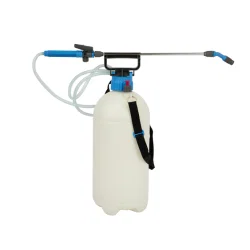Key features and considerations related to garden sprayers
2024-01-20
Choosing the right flower pot or planter involves considering the needs of the plants, the environment, and personal preferences. The diversity in materials and designs allows for creative and functional solutions for both indoor and outdoor gardening.
A garden sprayer is a handheld or backpack device designed to apply liquid substances, such as pesticides, herbicides, fertilizers, or water, to plants and garden areas. These sprayers are versatile tools commonly used by gardeners and homeowners for various gardening and landscaping tasks. Here are key features and considerations related to garden sprayers:
1. Types of Garden Sprayers:
- Handheld Sprayers: Small, portable sprayers operated by hand. Suitable for smaller gardens or targeted applications.
- Backpack Sprayers: Larger capacity sprayers worn on the back like a backpack. Ideal for larger areas or when more liquid needs to be applied.
2. Pump Mechanism:
- Manual Pump Sprayers: Require manual pumping to pressurize the tank before spraying.
- Battery-Powered Sprayers: Equipped with a battery-powered pump for easier pressurization without manual pumping.
- Motorized Sprayers: Powered by an electric motor for continuous spraying without manual effort.
3. Capacity:
- Small Capacity: Handheld sprayers typically have smaller capacities suitable for smaller tasks.
- Large Capacity: Backpack sprayers can hold larger volumes of liquid, making them suitable for more extensive applications.
4. Nozzle Types:
- Adjustable Nozzles: Allow for customization of spray patterns, such as stream, cone, or mist.
- Fan Nozzles: Distribute liquid over a wider area, ideal for covering larger sections.
- Jet Nozzles: Produce a concentrated stream, suitable for targeted applications.
5. Material Construction:
- Plastic Sprayers: Lightweight and affordable, suitable for general use.
- Metal Sprayers: More durable and resistant to chemical corrosion. Common in professional-grade sprayers.
6. Chemical Compatibility:
- Chemical-Resistant Materials: Ensure that the materials used in the sprayer are compatible with the chemicals or solutions being applied.
- Seals and Gaskets: Check for chemical-resistant seals and gaskets to prevent damage and leaks.
7. Pressure Relief Valve:
- Safety Feature: Some sprayers come with a pressure relief valve to release excess pressure and prevent over-pressurization.
8. Carrying Straps:
- Backpack Straps: Backpack sprayers are equipped with adjustable straps for comfortable and hands-free carrying.
- Carrying Handles: Handheld sprayers may have built-in handles for easy carrying.
9. Application Control:
- On/Off Valve: Allows control over when the sprayer is actively spraying, conserving liquid.
- Trigger Lock: Some sprayers have a trigger lock for continuous spraying without holding the trigger.
10. Maintenance:
- Cleaning: Regularly clean the sprayer after use to prevent clogs and maintain performance.
- Storage: Store the sprayer properly, especially during the off-season, to prevent deterioration.
11. Versatility:
- Multi-Purpose Use: Garden sprayers can be used for applying pesticides, herbicides, fertilizers, or simply watering plants.
- Adjustable Pressure: Sprayers with adjustable pressure settings provide versatility for different applications.
12. Budget Considerations:
- Affordability: Handheld sprayers are generally more affordable than backpack sprayers.
- Investment in Quality: Higher-quality sprayers with durable construction may be a worthwhile investment for long-term use.
Garden sprayers are essential tools for maintaining a healthy garden, controlling pests, and applying fertilizers. The choice between handheld and backpack sprayers depends on the scale of the gardening tasks and individual preferences. Regular maintenance and proper use contribute to the longevity and effectiveness of garden sprayers.



